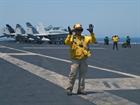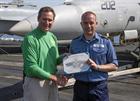First RN sailor qualifies to move aircraft on US carrier
US Top Gun pilots on one of the world’s busiest aircraft carriers are now taking their orders from a Royal Navy sailor.
Chief Petty Officer Stacy Gager is the first British sailor to qualify as an aircraft director on a US carrier after being put through an intense training programme on the USS Eisenhower.
Stacy, who is an aircraft handler by trade, is now trained to coordinate a continual stream of aircraft moving around the carrier as they prepare to fly or come into land on the deck.
A dangerous and intense job – the qualifications will stand him in good stead for the Royal Navy’s own future carrier-strike capability.
“I am really pleased,” he said. “I studied whenever I could and worked hard on the deck so that I could pass their exams just as their own US sailors do, so it made me very proud to get my qualification.
“I have really enjoyed the training on the US carrier – it has been exciting and something different.
"I wanted to do this from the first time it was mentioned and the first to be out here learning these new skills and bringing them back to the Royal Navy.”
Stacy is on board the USS Eisenhower along with three other RN aircraft handlers as part of a new scheme between the two countries called the Long Lead Specialist Skills Programme. A further three sailors are on board the USS Kearsarge. The idea is for Royal Navy sailors to regain specialist operational aircraft handling skills while the Queen Elizabeth class carriers are under construction.
RAF personnel are also included on the programme and around 300 personnel are expected to be trained by the end of the decade. The programme saw Stacy and his team join the US carrier east of Suez in January for up to nine months – with the plan to leave before the ship returns to the US. A further group of eight personnel will join the USS Truman in July to also train in flight deck operations, maintenance and weapon handling.
Lieutenant Commander Jon Llewellyn, aircraft handling staff officer at Navy Command HQ in Portsmouth said the programme was invaluable for when the HMS Queen Elizabeth comes into Service. He said,
“The feedback we have had from the team out there is has been a very valuable experience. It is pretty tough training for them and it is a feat in itself the difference in living and working in that environment."
“The flight deck is one of the most dangerous places to work in the world. You have to have an awareness of everything that is going on around you.– there are jet blasts coming from all around and aircraft landing and taking off.
“But as far as job satisfaction goes it is very very rewarding. They are enjoying learning the skills and putting what they already know into practice.
"This is what they signed up to do and they don’t get to do it very often. It is going to put us in good stead for our own carriers.”
All those chosen for the programme already have at least ten years’ experience of working with aircraft.
Those aboard the Kearsarge are working with Harriers (the US Marine Corps’ AV-8B variant) to marshal around the deck among other aircraft; while those on the Eisenhower are dealing with Super Hornet jets, Hawkeye early-warning aircraft, specialist Prowler electronic warfare jets, twin-propeller Greyhound transporters and Seahawk helicopters.
The days on the carrier are long – the teams work for 16 hours a day and have no access to rest or relaxation areas apart from the dining hall or their own bunks. During one operation Stacy arrived on deck at 6.15am and finished at 9.30pm.


